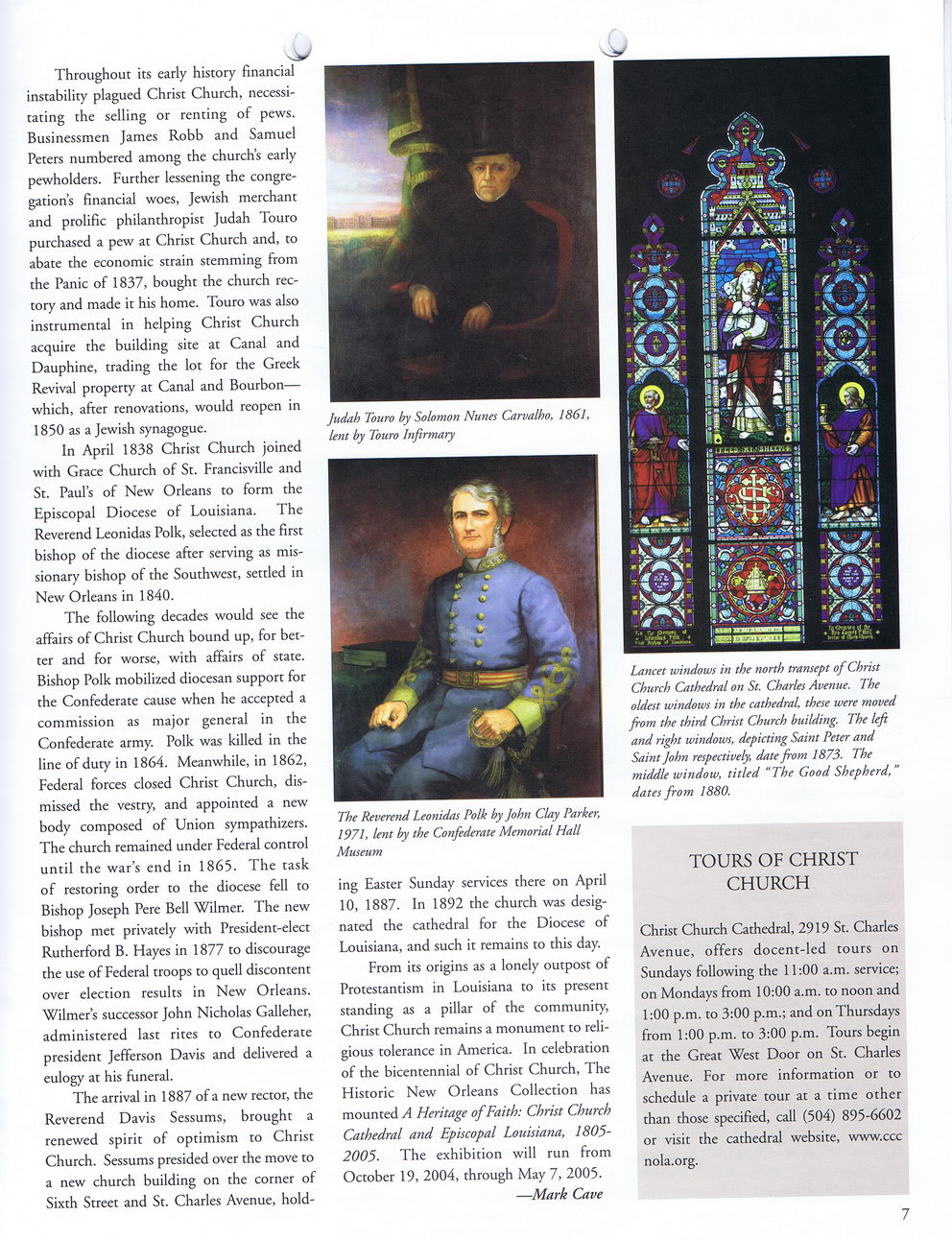This text was obtained via automated optical character recognition.
It has not been edited and may therefore contain several errors.
Throughout its early history financial instability plagued Christ Church, necessitating the selling or renting of pews. Businessmen James Robb and Samuel Peters numbered among the church?s early pewholders. Further lessening the congregation?s financial woes, Jewish merchant and prolific philanthropist Judah Touro purchased a pew at Christ Church and, to abate the economic strain stemming from the Panic of 1837, bought the church rectory and made it his home. Touro was also instrumental in helping Christ Church acquire the building site at Canal and Dauphine, trading the lot for the Greek Revival property at Canal and Bourbon? which, after renovations, would reopen in 1850 as a Jewish synagogue. In April 1838 Christ Church joined with Grace Church of St. Francisville and St. Paul?s of New Orleans to form the Episcopal Diocese of Louisiana. The Reverend Leonidas Polk, selected as the first bishop of the diocese after serving as missionary bishop of the Southwest, settled in New Orleans in 1840. The following decades would see the affairs of Christ Church bound up, for better and for worse, with affairs of state. Bishop Polk mobilized diocesan support for the Confederate cause when he accepted a commission as major general in the Confederate army. Polk was killed in the line of duty in 1864. Meanwhile, in 1862, Federal forces closed Christ Church, dismissed the vestry, and appointed a new body composed of Union sympathizers. The church remained under Federal control until the war?s end in 1865- The task of restoring order to the diocese fell to Bishop Joseph Pere Bell Wilmer. The new bishop met privately with President-elect Rutherford B. Hayes in 1877 to discourage the use of Federal troops to quell discontent over election results in New Orleans. Wilmer?s successor John Nicholas Galleher, administered last rites to Confederate president Jefferson Davis and delivered a eulogy at his funeral. The arrival in 1887 of a new rector, the Reverend Davis Sessums, brought a renewed spirit of optimism to Christ Church. Sessums presided over the move to a new church building on the corner of Sixth Street and St. Charles Avenue, hold- Judah Touro by Solomon Nunes Carvalho, 1861, lent by Touro Infirmary The Reverend Leonidas Polk by John Clay Parker, 1971, lent by the Confederate Memorial Hall Museum ing Easter Sunday services there on April 10, 1887. In 1892 the church was designated the cathedral for the Diocese of Louisiana, and such it remains to this day. From its origins as a lonely outpost of Protestantism in Louisiana to its present standing as a pillar of the community, Christ Church remains a monument to religious tolerance in America. In celebration of the bicentennial of Christ Church, The Historic New Orleans Collection has mounted A Heritage of Faith: Christ Church Cathedral and Episcopal Louisiana, 1805-2005. The exhibition will run from October 19, 2004, through May 7, 2005-?Mark Cave _ >M V J r* [jwrffirrjiii **+ ?> lmwlan Lancet windows in the north transept of Christ Church Cathedral on St. Charles Avenue. The oldest windows in the cathedral, these were moved from the third Christ Church building. The left and right windows, depicting Saint Peter and Saint John respectively, date from 1873. The middle window, titled ?The Good Shepherd, ? dates from 1880. TOURS OF CHRIST CHURCH Christ Church Cathedral, 2919 St. Charles Avenue, offers docent-led tours on Sundays following the 11:00 a.m. service; on Mondays from 10:00 a.m. to noon and 1:00 p.m. to 3:00 p.m.; and on Thursdays from 1:00 p.m. to 3:00 p.m. Tours begin at the Great West Door on St. Charles Avenue. For more information or to schedule a private tour at a time other than those specified, call (504) 895-6602 or visit the cathedral website, www.ccc nola.org. 7

Battle of 1814 2